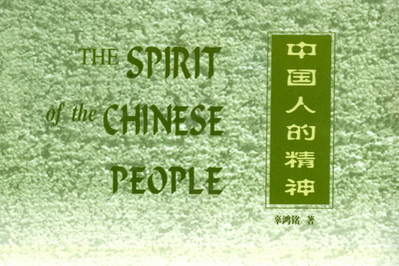
The Chinese Woman (selected)
From the Spirit of the Chinese People, by Ku Hung-Ming, 1915
… … For the womanhood in a nation is the flower of the civilization, of the state of civilization in that nation.
But now to come to our question: what is the Chinese feminine ideal? The Chinese feminine ideal I answer, is essentially the same as the old Hebrew feminine ideal with one important difference of which I will speak later on. The Chinese feminine ideal is the same as the old Hebrew ideal in that it is not an ideal merely for hanging up as a picture in one’s room; nor an ideal for a man to spend his whole life in caressing and worshipping. The Chinese feminine ideal is an ideal with a broom in her hands to sweep and clean the rooms with. In fact the Chinese written character for a wife (妇) is composed of two radicals – (女) meaning a woman and (帚) meaning a broom. In classical Chinese, in what I have called the official uniform Chinese, a wife is called the Keeper of the Provision Room – a Mistress of the Kitchen. Indeed the true feminine ideal, — the feminine ideal of all people with a true, not tinsel civilization, such as the old Hebrew, the ancient Greeks and the Romans, is essentially the same as the Chinese feminine ideal: the true feminine ideal is always the Hausfrau, the house wife, la dame de ménage or chatelaine.
But now to go more into details. The Chinese feminine ideal, as it is handed down from the earliest time, is summed up in three obediences and Four Virtues. Now what are the four virtues? They are: first womanly character; second, womanly conversation; third, womanly appearance; and lastly, womanly work. Womanly character means not extraordinary talents or intelligence, but modesty, cheerfulness, chastity, constancy, orderliness, blameless conduct and perfect manners. Womanly conversation means not eloquence or brilliant talk, but refined choice of words, never to use coarse or violent language, to know when to speak and when to stop speaking. Womanly appearance means not beauty or prettiness of face, but personal cleanliness and faultlessness in dress and attire. Lastly, womanly work means not any special skill or ability, but assiduous attention to the spinning room, never to waste time in laughing and giggling and work in the kitchen to prepare clean and wholesome food, especially when there are guests inthe house. These are the four essentials in the conduct of a woman as laid down in the in “Lessons for Women”, written by Ts’ao Ta Ku or Lady Ts’ao, sister of the great historian Pan Ku of the Han Dynasty.
Then again what do the Three Obediences in the Chinese feminine ideal mean? They mean really three self sacrifices or “live for”s? That is to say, when a woman is unmarried, she is to live for her father; when married, she is to live for her husband; and, as a widow, she is to live for her children. In fact, the chief end of a woman in China is not to live for herself, or for society; not to be a reformer or to be president or the woman’s natural feet Society; not to live even as a saint or to do good to the world; the chief end of a woman in China is to live as a good daughter, a good wife and a good mother.
A foreign lady friend of mine once wrote and asked me whether it is true that we Chinese believe, like the Mohammedans, that a woman has no soul. I wrote back and told her that we Chinese do not hold that a woman has no soul, but that we hold that a woman, — a true Chinese woman has no self.
… … In short, the real or true Chinese woman is chaste; she is bashful, has pudeur; and she is attractive and debonair. This then is the Chinese feminine ideal, — the “Chinese Woman.”